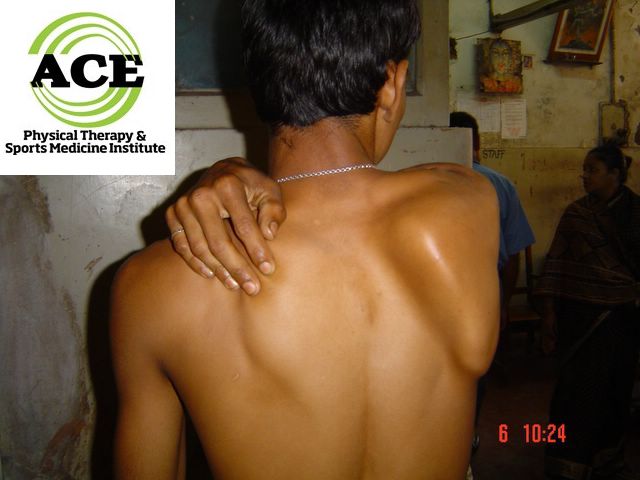WINGING SCAPULA DUE TO A NERVE INJURY

Tid Bits of Info
- The long thoracic nerve is only a motor nerve and it innervates the Serratus Anterior muscle.
- Damage to the long thoracic nerve will lead to “winging” of the scapula.
- Abnormal scapula motion is referred to as scapular “dyskinesis.”
- Long thoracic nerve damage leads to medial (near the spine) scapular winging.
- If you have a painful shoulder and suspect that it is “winging” seek the advice and treatment of a Physical Therapist
Scapula winging or a winged scapula is rare condition that causes the shoulder blade to stick out from the back. This can cause pain in completing normal activities like slipping on a shirt or brushing teeth. One common cause is an injured long thoracic nerve due to overuse in sports or other activities. Physical Therapists commonly provide non-surgical treatment protocols that reduce pain and restore normal shoulder function.
Causes of Winging Scapula
The shoulder joint is a complex joint that has the capability to move in every plane of motion. The bones of the joint need to move together as a “team” or an injury can occur. Many individuals have pain in the shoulder joint due to the abnormal movement one or more bones. One of the key components to proper shoulder motion is the position of the shoulder blade (scapula). This bone is the anchoring point of every shoulder muscle and when it moves too much or too little the joint structures can be compromised and injured.
The shoulder joint is comprised of three bones: scapulae, clavicle, and humerus. The head of the humerus rests on the Glenoid fossa of the scapula where it articulates when the muscles of the shoulder contract to move the arm. If the muscles are performing correctly, the round humeral head remains in the center of the fossa during all motions. Unfortunately, the muscles can be injured which leads to an imbalance and abnormal motions.
The shoulder blade has to remain in proper position during any motion or the head of the humerus cannot remain situated in the glenoid fossa in the correct place. There are “back” muscles that attach to the scapula border closest to the spine that help to control and stabilize the scapula as it moves. There is one very large muscle, serratus anterior (SA), that is located along the side of the rib cage that attaches to the scapula and helps to control its movements. This muscle has three distinct fiber orientations and each one helps to produce a specific movement of the scapula. The upper fibers “anchor” it to the ribs and allow the scapula to “pivot”. The middle fibers are oriented in a way that enables them to facilitate protraction. Finally, the lower portion or the most inferior fibers attach to the inferior angle of the scapula and are responsible for upward rotation and posterior tilt. These two motions are extremely important when someone wants to perform an activity that requires movement of the arm above shoulder level.
A muscle’s action is dependent upon a signal or impulse sent from a nerve. The SA’s capability to perform its functions is dependent upon the long thoracic nerve. This nerve sends motor signals only and does not get involved with any sensory information. If this nerve is damaged in any way, the SA can be adversely affected and lead to improper shoulder motions due to abnormal scapula function.
Long Thoracic Nerve Injuries
The long thoracic nerve can be injured in many ways. The muscles in the neck region can compress it, the over-hand throwing motion can stretch it, contact sports can move the head one way and the shoulder another which stretches it too far, acute trauma and various other structures can compress it causing damage. In any of these situations, the patient will present with abnormal shoulder mechanics.
Symptoms of Winging Scapula
The most pronounced symptom of an injured long thoracic nerve is referred to “winging” of the scapula. The serratus anterior muscle is not able to perform its role and the vertebral border of the scapula “lifts off” the rib cage. The shoulder blade appears to be disconnected from the ribs. The “winging” position places abnormal stress and strain on all of the soft tissues of the shoulder. This eventually leads to pain and dysfunction. In a throwing athlete, their performance will be greatly effected in a negative way where they will suffer from pain, loss of strength and accuracy.

Treatment for Restoring Shoulder Health
Diagnosis of damage to the long thoracic nerve has to be done with an EMG but a physical examination of shoulder movement is usually very reliable. The primary goal of treatment is to re-establish the normal health to the long thoracic nerve which requires eliminating the primary cause be it over-stretch or compression.
Physical Therapists are well trained to evaluate the shoulder’s mechanics and movements. They will assess the shoulder motion with and without resistance. From their findings, they establish a treatment protocol that will address the symptoms and help to eliminate the problems. This thorough approach enables them to restore the normal function and movement of the shoulder. This process is slow and usually takes 6-9 months but conservative treatment is usually successful.
Treating a scapula that has dysfunctional motion is very common in the out –patient orthopaedic physical therapy setting. The symptoms that get the patient to seek medical attention are usually pain and weakness in the involved shoulder. In most instances, a Physical Therapist can help develop a treatment plan that will re-establish normal shoulder mechanics in a person who has suffered damage to the long thoracic nerve which compromised the SA performance.
























